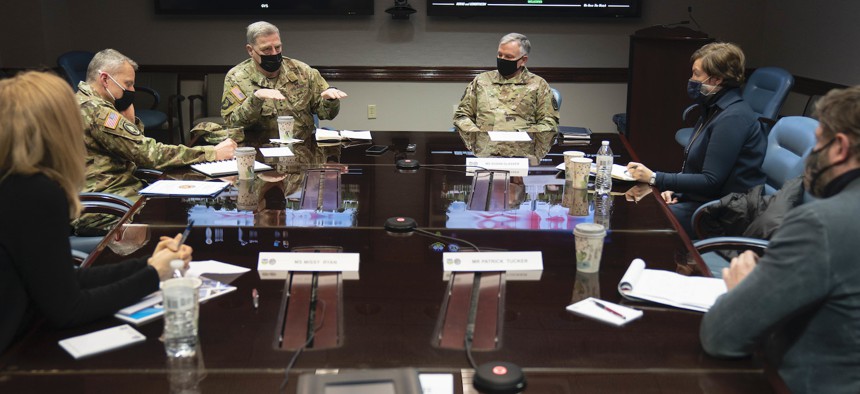PATRICK TUCKER

Using artificial intelligence for rapid data collection and integration of shrunk the commander's decision cycle from days to minutes in some instances in a recent information experiment by U.S. Northern Command, the head of NORTHCOM said Wednesday.
Speaking to reporters at the Pentagon, Gen. Glen VanHerck said the Global Information Dominance Exercise or GIDE, “focused a lot on contested logistics to give us a scenario where maybe a line of communication such as the Panama Canal may be challenged,” by a peer competitor such as China or Russia. The experiment wrapped up during the second week of July.
The experiment was hosted by NORTHCOM but included 11 combatant commands, which illustrated how they can integrate and act on data from satellites, planes, and other sources. It also tested the command’s ability to use new artificial intelligence abilities to monitor and predict potential threats using those data sources.
“We would take artificial intelligence and use machine learning to take a look and assess, for example, the average number of cars in a parking lot… maybe they're in a specific location to a competitor or threat, and we monitor that over a period of time. The machine learning and the artificial intelligence can detect changes in that, and we can set parameters where it will trigger an alert to give you the awareness to go [and] take another sensor system such as [intelligence, surveillance and reconnaissance satellites in geosynchronous orbit] and take a closer look at what might be ongoing in a specific location.”
He described the effect as transformative in terms of accelerating command decision-making. “This gives us days of advanced warning and ability to react. Where in the past, we may not have put eyes on with an analyst of a [geo-intelligence] satellite image. Now, we are doing that within minutes, or near real time. That's the primary difference that I'm talking about.”
It’s the sort of experimentation that the military has been doing more of at the service level, as part of efforts to develop new, highly networked warfare capabilities sometimes called Joint All-Domain Command and Control, or JADC2.
VanHerck, in his remarks, sought to differentiate what NORTHCOM is doing from some of the experimentation that is coming out of the Air Force with its series of Advanced Battle Management on-ramps, or the Army with its Project Convergence experiment. He framed it less as an effort to develop new tools and more of a test to see if operators across platforms and services can actually use those tools and implement new concepts, particularly around rapid data collection and sharing.
“You've heard all the services moving out to develop these capabilities. The primary difference between what I'm doing and what the services are doing is I'm focused at the operational to strategic level, taking data and information that is available today that's key...We're not creating new capabilities to go get data and information. This information exists from today's satellites, today's radar, today's undersea capabilities, today’s cyber, today's intel capabilities. The data exists. What we're doing is making that data available… and shared into a cloud, where machine learning and artificial intelligence look at it and they process it really quickly and provide it to decision makers, which I call decision superiority.”
NORTHCOM is farther ahead in some respects than most other elements of the U.S. military in developing and testing key elements of the JADC2 concept. During the height of the pandemic in 2020, NORTHCOM tested how to integrate new data from troops on the ground armed with handheld tablets, commercial data from retailers, and other sources to rapidly predict things like supply shortages and even possible future virus hotspots, in order to pre-position assets.
VanHerck cautioned that while he was pleased with the recent experiment’s outcome, the success of new data integration efforts will hinge heavily on the department’s ability to better secure networking capabilities, especially under harsh conditions.
“Going forward, the [information technology] infrastructure has to be secure and reliable to execute future data and information and capability, so I think that's something we have to focus on,” he said.
VanHerck also stressed that public—and even lawmaker—perceptions about how the U.S. military uses AI will be a factor. Misperceptions about commanders ceding human control could contribute to resistance against further deployment and experiments.
“I also think that we need to build competence and understanding of AI and machine learning across not only the department, but within Congress and the American people, to ensure they understand that machines aren't making decisions. We’re not relying on computers to take us to create deterrence options or defeat options.”
No comments:
Post a Comment